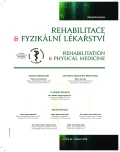Robotic Rehabilitation of the Hand Spasticity
Authors:
P. Konečný 1,2,3,4,5; M. Tarasová 3; J. Kubíková 1; M. Vernerová 1
Authors‘ workplace:
CLR SMN Agel Prostějov
primář MUDr. P. Konečný, Ph. D., MBA
1; Fyzioterapie FZV UP, Olomouc
přednosta doc. MUDr. A. Krobot, Ph. D.
2; KFRL LF MU, Brno
prof. MUDr. P. Dobšák, CSc.
3; ICRC FNUSA, Brno
ředitel Gorazd B. Stokin, M. D., MSc., Ph. D.
4; Neurologická klinika LF UP, Olomouc
přednosta prof. MUDr. P. Kaňovský, CSc.
5
Published in:
Rehabil. fyz. Lék., 24, 2017, No. 1, pp. 19-22.
Category:
Original Papers
Overview
Introduction:
Spasticity is an integral part of spastic syndrome with high incidence in diseases of central nervous system. The principal problems of the spastic syndrome include paresis, muscle shortening and dystonia. The muscle shortening and muscular hypertonia can be influenced pharmacologically, by neurorehabilitation techniques and progressive stretching techniques. Robotic technologies, providing optimal repeated rehabilitation stretching of spastic muscles can be used as supplement or substitution of the stretching techniques. One such robot fulfilling the requirements for therapy of the hand finger spasticity is the robotic glove Gloreha Professional II.
Methods:
The study aimed at verification of the effects of robotic therapy in patients after brain vascular event (6 to 60 months after the origin) wit spastic hand paresis in a degree according to modified Ashworth scale (MAS) 1 – 3. The prospective randomized study of 20 cases and 18 controls evaluates the changes in the grip by the SVH test (score of visual evaluation of hand grip strength test) and changes in finger spasticity after eight weeks of treatment. The experimental group underwent a complex antispastic therapy (administration of botulinum toxin, 300 Speywood units Dysport botox – fractionated into the surface and deep flexor of fingers, physiotherapy for 5 hours weekly and ergotherapy 2.5 hour weekly). The control group was treated by the conventional complex therapy.
Results:
In the experimental group there were statistically significant changes in diminution of spasticity (MAS median form 2 to 1 in the experimental group versus 2 to 1+ in the control group) and an improvement in the hand grip functions (SVH from median of 10 entry to 15 on the output in the experimental group against SVH in median 11 to 13). However, the results were not significant at the P=0.05 level.
Conclusion:
The robotic rehabilitation has an important influence in antispastic treatment of fingers with perspective therapeutic results, as our study has shown.
Keywords:
spasticity, hand, robotic-assisted rehabilitation
Sources
1. BISSOLOTTI, L., VILLAFAÑE, J., H., GAFFURINI, P. et al.: Changes in skeletal muscle perfusion and spasticity in patients with poststroke hemiparesis treated by robotic assistance (Gloreha) of the hand. J. Phys. Ther. Sci., 28, 2016, 3, s. 769-773.
2. BORBONI, A., VILLAFAÑE, J., H., MULLÈ, C. et al.: Robot-assisted rehabilitation of hand paralysis after stroke reduces wrist edema and pain: A prospective clinical trial. J. Manipulative Physiol. Ther., 16, 2016, 12, s. 30245-30247.
3. EHLER, E.: Spasticita – klinické škály. Neurol. Praxi., 16, 2015, 1, s. 20-30.
4. GÁL, O., HOSKOVCOVÁ, M., JECH, R.: Neuroplasticita, restituce motorických funkcí a možnosti rehabilitace spastické parézy. Rehabil. fyz. Lék., 22, 2015, č. 3, s. 101-127.
5. GLOREHA – HAND REHABILITATION GLOVE [ONLINE]. Dostupné z:http://www.gloreha.com/ [cit. 11. 11. 2016].
6. GRACIES, J. M. et al.: Safety and efficacy of abotulinumtoxinA for hemiparesis in adults with upper limb spasticity after stroke or traumatic brain injury. Lancet Neurol., 14, 2015, 10, s. 992-1001.
7. HILLEROVÁ, L., MIKULECKÁ, E., MAYER, M., VLACHOVÁ, I.: Statistické vlastnosti nové škály - skóre vizuálního hodnocení funkčního úkolu ruky u pacientů po cévní mozkové příhodě. Rehabil. fyz. Lék., 13, 2006, 3, s. 107-111.
8. KAŇOVSKÝ, P., BAREŠ, M., DUFEK, J. et al.: Spasticita, mechanismy, diagnostika, a léčba. Praha, Maxdorf, 2004.
9. KINNEAR, B. Z. et al.: Rehabilitation terapies after Botulinum Toxinu-A injection to manage limb spasticity. Phys. Ther., 94, 2014, s.1569-1581.
10. KONECNY, P. et. al.: Rehabilitation of spasticity in patients with stroke. In: Kerner, T. et al.: Noninvasive methods in cardiology. Brno, Masarykova Univerzita, 2013.
11. ŘÍHA, M., DVOŘÁKOVÁ, P.: Léčba fokální spastické parézy po získaném poškození mozku. Rehabil. fyz. Lék., 22, 2015, č. 3, s. 140-143.
12. ŠTĚTKÁŘOVÁ, I., EHLER, E., JECH, R. et al.: Spasticita a její léčba. Praha, Maxdorf, 2012.
13. ŠTĚTKÁŘOVÁ, I.: Léčba spasticity dospělých. Med. Praxi, 9, 2012, 3, s. 124-126.
14. VANOGLIO, F., BERNOCCHI, P., MULÈ, C. et al: Feasibility and efficacy of a robotic device for hand rehabilitation in hemiplegic stroke patients: A randomized pilot controlled study. Clin. Rehabil., 2016, doi: 10.1177/0269215516642606.
Labels
Physiotherapist, university degree Rehabilitation Sports medicineArticle was published in
Rehabilitation & Physical Medicine

2017 Issue 1
- Hope Awakens with Early Diagnosis of Parkinson's Disease Based on Skin Odor
- Deep stimulation of the globus pallidus improved clinical symptoms in a patient with refractory parkinsonism and genetic mutation
Most read in this issue
- Robotic Rehabilitation of the Hand Spasticity
- Electrostimulation as an Effective Tool in Therapy of Vocal Cords
- Prop Up Movement Patterns and their Effect on Patients after Total Hip Replacement
- A Photomechanic Effect of High-Intensity Laser of Class 4 1064nm on the Pain Transfer Via Free Nerve Endings: a Multi-Centric, Randomized, Placebo-Controlled Study
